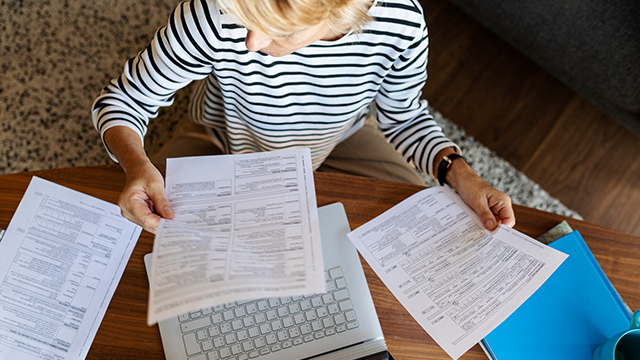Simply put, a business loan is a way for companies to borrow funds for business purposes, from bolstering working capital (the money the business has available to cover short-term overhead) to purchasing commercial property. These loans are typically paid back in regular installments with associated fees and interest, depending on the lender and your qualifications.
What is a business loan and how do I get one?
August 8, 2025 | 6 minute read

Answered by
Roderick Wilson
Small Business Lending Product Executive
Bank of America
What are some of the required documents that I need?
The specific requirements depend on the lender and the type and size of the loan. But there are core items you should be prepared to provide:
- Name of the business
- Business street address and date you moved there
- Business phone number
- Business tax ID number
- Nature of the business
- How long the business has been in operation
- Number of employees
- The business plan or purpose of the loan
- The Social Security numbers of those who own 20% or more of the business, depending on the lender
The lender will also typically want to see two to three years of the most recent financial information, such as:
- Personal tax returns
- Business tax returns
- Profit and loss statements
- Bank statements
- A personal financial statement
You may also need to provide:
- A current balance sheet
- Financial projections
- The type of collateral you’re using if the loan will be secured, such as commercial real estate or equipment
Beyond that, lenders that require personal guarantees will also require the business owner’s personal credit history and scores along with bank statements, to understand what liquid assets the business has on hand and the owner’s ability to repay the debt if the business cannot.
What are the different types of business loans to consider?
Conventional loans or term loans are better suited for businesses with an established operating history. They’re usually used for construction and the purchase of equipment, real estate or acquiring another business. Because they’re secured with collateral such as real estate, they tend to have higher minimum amounts of $25,000 and up. These loans will be due in a set period or term, generally from 18 months to five years, and they may have a fixed or variable interest rate. Typically, there is a monthly or quarterly repayment schedule.
A Small Business Administration (SBA) loan1 is a business loan that is partially guaranteed by the U.S. Small Business Administration and made by private lenders. Because of the reduced risk to lenders provided by the SBA guaranty, businesses are generally able to access capital more easily, with longer loan terms and lower down payment requirements as compared to conventional loans. SBA loans can be used for a variety of purposes, including working capital, business purchase and expansion, equipment financing, and commercial real estate purchase and refinance.
Next up are secured business lines of credit. Think of them as flexible, on-demand pools of money that are available when needed and are usually used to smooth cash flow needs or seize an unexpected opportunity. You pay interest on the money you use along with setup fees for some lines of credit.
Finally, there are unsecured lines of credit and unsecured business loans that generally start at $10,000 and are typically for smaller needs. You don’t have to put up collateral but expect stricter terms and higher interest rates.
What is collateral and how do I meet the collateral requirements for a loan?
Collateral is property that a borrower pledges as security toward loan repayment and is a common business loan requirement. If the borrower can’t pay back their loan, the lender takes the property. Lenders will consider each unique situation, but will look at some variation of what’s known as the six C’s of credit to gauge your creditworthiness. Collateral is one of the six C’s. The others are capacity, capital, conditions, character and communication. Many small business owners apply for loans secured by collateral because these loans usually offer lower interest rates than unsecured loans.
It’s a good idea to check in with your small business banker to determine what can be used for collateral. For example, in addition to residential or commercial real estate, collateral could include the assets of the business (such as accounts receivable, inventory or cash) or equipment, depending on the loan.
How to apply for a business loan in 4 steps
To apply for a business loan, do the following:
- Decide where to apply. Typically, you will need to use a bank or online lender.
- Follow the instructions on the application. Each lender has its own rules.
- Gather your application materials. You’ll need detailed information on your business, such as your business’s official name and tax ID, a plan detailing how you will use the loan, financial documentation such as a profit and loss statement, and the names and Social Security numbers of those who own 20% or more of your company, depending on the lender.
- Double-check your loan application, then provide all the requested items and input. Missing information can slow the approval process.
How long does the application process take?
Typically, the entire process takes anywhere from three or four weeks for a line of credit to possibly a few months for a commercial mortgage. However, unsecured lines and loans, which are generally for small dollar needs, take less time and can be decisioned in about a week. It’s best to come in as soon as you realize you may need funds, so you can start the application process early.
What happens during underwriting?
Once you’ve filled out all the forms and the bank has the necessary documents in hand, the loan goes through underwriting. This is where lenders verify your income, assets, debt and details about any property you’ve listed as collateral. Lenders might also examine your personal and business financial histories.
Small business owners are sometimes surprised that their proposed collateral isn’t sufficient for the size loan they want. Lenders look at the loan-to-value ratio, or the loan amount divided by the collateral’s value. All things being equal, the lower the better. It’s a good idea to call your small business banker if you have concerns that your existing collateral can’t meet loan-to-value standards. They may be able to help you identify other assets that can be used to meet the requirements.
When is the right time to apply for a business loan?
There are many occasions when it makes sense to apply for a business loan:
- To purchase assets that will add to the long-term value of your business or help you increase your revenue
- To grow your business
- To enhance your cash flow
- To help you build your business’s credit score
Financial institutions will need the business to demonstrate they have been operating for at least two years. Startups that may need financing often benefit from establishing a deposit relationship with a financial institution before they need credit to build a relationship with their bank.
1 Requires approval through the SBA 7(a), SBA 504 or SBA Express programs and subject to SBA guidelines. Subject to approval under Bank of America’s credit standards, loan terms, collateral, and documentation requirements. Products and programs of Bank of America are subject to change at any time.
Explore more
Get help finding the right products and services for your business
Answer a few simple questions to receive tailored business banking solutions.
Financing options for businesses
Throughout the life of your business you may need to secure outside funding. Learn about traditional and alternative financing options that can help you achieve your goals.
Important Disclosures and Information
Bank of America, Merrill, their affiliates and advisors do not provide legal, tax or accounting advice. Consult your own legal and/or tax advisors before making any financial decisions. Any informational materials provided are for your discussion or review purposes only. The content on the Center for Business Empowerment (including, without limitations, third party and any Bank of America content) is provided “as is” and carries no express or implied warranties, or promise or guaranty of success. Bank of America does not warrant or guarantee the accuracy, reliability, completeness, usefulness, non-infringement of intellectual property rights, or quality of any content, regardless of who originates that content, and disclaims the same to the extent allowable by law. All third party trademarks, service marks, trade names and logos referenced in this material are the property of their respective owners. Bank of America does not deliver and is not responsible for the products, services or performance of any third party.
Not all materials on the Center for Business Empowerment will be available in Spanish.
Certain links may direct you away from Bank of America to unaffiliated sites. Bank of America has not been involved in the preparation of the content supplied at unaffiliated sites and does not guarantee or assume any responsibility for their content. When you visit these sites, you are agreeing to all of their terms of use, including their privacy and security policies.
Credit cards, credit lines and loans are subject to credit approval and creditworthiness. Some restrictions may apply.
Merrill Lynch, Pierce, Fenner & Smith Incorporated (also referred to as “MLPF&S” or “Merrill”) makes available certain investment products sponsored, managed, distributed or provided by companies that are affiliates of Bank of America Corporation (“BofA Corp.”). MLPF&S is a registered broker-dealer, registered investment adviser, Member SIPC, and a wholly owned subsidiary of BofA Corp.
Banking products are provided by Bank of America, N.A., and affiliated banks, Members FDIC, and wholly owned subsidiaries of BofA Corp.
“Bank of America” and “BofA Securities” are the marketing names used by the Global Banking and Global Markets division of Bank of America Corporation. Lending, derivatives, other commercial banking activities, and trading in certain financial instruments are performed globally by banking affiliates of Bank of America Corporation, including Bank of America, N.A., Member FDIC. Trading in securities and financial instruments, and strategic advisory, and other investment banking activities, are performed globally by investment banking affiliates of Bank of America Corporation (“Investment Banking Affiliates”), including, in the United States, BofA Securities, Inc., which is a registered broker-dealer and Member of SIPC, and, in other jurisdictions, by locally registered entities. BofA Securities, Inc. is a registered futures commission merchant with the CFTC and a member of the NFA.
Investment products:

.jpg)
